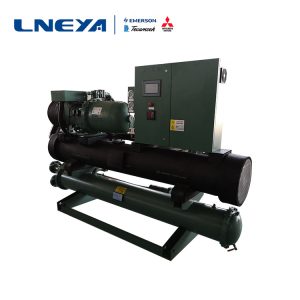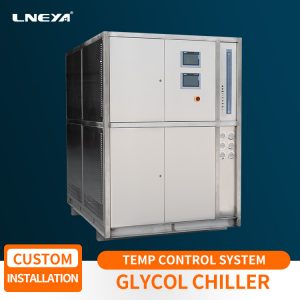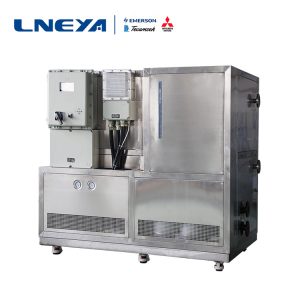Análisis del principio de funcionamiento del termostato de refrigeración y calefacción
Con el continuo desarrollo de la tecnología, más y más equipos de refrigeración ha aparecido en nuestras vidas, tales como: circuladores de refrigeración y calefacción, de hecho, no son ordinarios, son notables equipos de refrigeración. Los equipos de refrigeraci...
The refrigeration heating circulator uses a limited amount of refrigerant in a closed refrigeration system to repeatedly compress, condense, expand, and evaporate the refrigerant, and continuously absorbs heat and vaporizes at the evaporator to perform cooling and cooling. The process of cooling the object to below ambient temperature and maintaining the low temperature by the refrigerant moving the heat from a low temperature object (such as a cold storage) to a high temperature object is achieved by using a refrigeration device.
An important parameter of the refrigeración calefacción circulador is the refrigeration coefficient, also known as the operating coefficient of the refrigeration unit, indicated by the symbol COP. The refrigeration heating circulator Xiaobian tells everyone that at a certain ambient temperature, the lower the cold storage temperature, the smaller the cooling coefficient.
So, what are its advantages?
The entire liquid circulation is hermetic, with an expansion vessel, the expansion vessel and the liquid circulation are adiabatic, do not participate in the liquid circulation, but are mechanically connected, regardless of whether the temperature of the liquid circulation is high temperature or the medium in the low temperature expansion vessel is less than 60 degrees. .
The entire liquid circulation is a closed system. There is no absorption of water vapor at low temperatures. There is no oil mist at high temperatures. The heat transfer oil can have a wide operating temperature; mechanical and electronic valves are not used in the entire circulation system.
Next, let’s look at the refrigeration principle of the refrigeration heating circulator.

Compressed air refrigeration cycle
Since the air temperature heating and the constant temperature heat removal are not easy to achieve, it cannot be operated in the reverse cycle. In the compressed air refrigeration cycle, two constant pressure processes are used to replace the two constant temperature processes of the reverse cycle, so it can be regarded as a reverse cycle. In engineering applications, the compressor can be piston or impeller.
Compressed vapor refrigeration cycle
The reverse refrigeration cycle of compressed steam can be theoretically achieved, but a state of too low dryness will occur, which is not conducive to the compression of two-phase materials. Refrigeration heating circulators, which tell you that in order to avoid adverse factors, increase cooling efficiency and simplify equipment, throttle valves (or expansion valves) are often used instead of expanders in practical applications.
The compressed vapor refrigeration cycle uses a low-boiling substance as a refrigerant, and utilizes the constant pressure in the wet vapor zone to determine the temperature, and the constant pressure gasification endothermic refrigeration at a low temperature can overcome some of the disadvantages of the above-mentioned compressed air and regenerative compressed air circulation.
Absorption refrigeration cycle
The absorption refrigeration cycle utilizes the different solubility characteristics of the refrigerant at different temperatures in the solution, so that the refrigerant is absorbed by the absorbent (ie solvent) at a lower temperature and pressure, while at the same time making it at a higher temperature and pressure. Evaporate from the solution and complete the cycle for refrigeration purposes.
Recomendaciones relacionadas
-
Characteristics of the evaporator of LNEYA screw chiller
1609The amount of cooling capacity of the screw chiller is directly related to the energy consumption and operational economics of the entire unit, which is worthy of attention. Especially when designing a cold station, there is no single chiller in t...
Ver detalles -
The difference between a large refrigeration and heating circulator and a test chamber
9001. For the high temperature test under special circumstances, the high and low temperature test chamber may not meet the requirements. Generally speaking, the high temperature upper limit of the high and low temperature test box is 200 ℃, and its ...
Ver detalles -
TCU temperature control model selection and technical parameter description
1275TCU temperature control is also a two-cycle unit single-fluid temperature control system. When selecting the model, it is very important for the whole temperature control reaction. Only the appropriate reaction system is used to exotherm and absor...
Ver detalles -
What Are The Characteristics Of The Reactor Heating System?
790Wuxi Guanya LNEYA reactor heating system The liquid circulation of the whole system is closed, the system has an expansion vessel, the expansion vessel and the liquid circulation are adiabatic, do not participate in the liquid circulation, only th...
Ver detalles
 LNEYA Enfriadoras industriales Fabricante Proveedor
LNEYA Enfriadoras industriales Fabricante Proveedor














